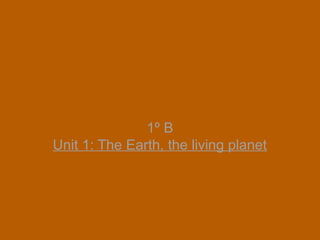
The Earth, Our Living Planet in Motion
- 1. 1º B Unit 1: The Earth, the living planet
- 2. The universe, the solar system and the Earth The universe has begun 13.700 milion of years ago. includes: ●celestial bodies (stars, planets, satellites...) ●intergalactic matter (dust and gas) ●intergalactic space
- 3. The celestial bodies form Galaxies Each galaxy contains milions of milions of stars and many planetary systems
- 4. The planetary systems consists of ●A star ●the celestial bodies that go around it (planets, satellites, asteroids and comets).
- 5. The Earth, the living planet - was formed 4.600 milions of years ago, like the Sun and all the solar system. - is the only planet with life
- 6. Why the Earth is the only planet with life? 1. Temperature is moderate. 2. The atmosphere contains essential gases for human life, as oxygen. Besides, the atmosphere protects us from unhealthy solar radiations and it helps us keeping its temperature. 3. The Earth has plenty of liquid water. This water is a large part of the Earth's surface, forming oceans and seas, for this reason, we see the Earth from space blue.
- 7. Shape and dimensions of the Earth -The Earth' shape is almost spherical which is why it is represented by a globe. -The Earth has 510 milions of km2, a thousand times Spain' surface. -The Earth is a small celestial body in the whole universe.
- 8. The Earth in motion The universe and its asteroids are constantly moving. The Earth is constantly moving Rotation Orbiting
- 9. Rotation Rotation is the turning of the Earth around its imaginary axis; at either end of the axis are the poles. A full rotation takes 24 hours (a day) The main consequences of the Earth’s movement are the change from day to night and vice versa.
- 10. Whats happen if the Earth doesn’t rotate? I f t h e E a r t h d o e s n o t r o t a t e , h a l f o f t h e p l a n e t w o u l d a l w a y s b e l i g h t a n d t h e t e m p e r a t u r e w o u l d b e e x t r e m e l y h o t w h i l e t h e o t h e r h a l f w o u l d b e i n d a r k n e s s a n d w o u l d b e e x t r e m l y c o l d .
- 11. Orbiting The orbit is the movement of the Earth around the Sun. It takes 365 days, 6hours and 9 minutes.
- 12. Consequences of the Earths' orbit ● The season of the year: Due to orbiting and the inclination of the Earth's axis, each of the two hemispheres has a different exposure (exposición) to the Sun's rays. - In summer the rays fall directly on one hemisphere, while the other receives them with a strong inclination, making winter. - In spring and autumn the rays fall on both hemispheres with the same inclination. When it is spring in one hemisphere it is autumn in the other. ● Different duration of night and days. ●The different climate zones: depending on the latitude, the Sun's rays fall with a different inclination. We can distinguish: - One warm zone -Two temperate zones. Cold zone - Two cold zones. Warm zone Temperate zone Cold zone